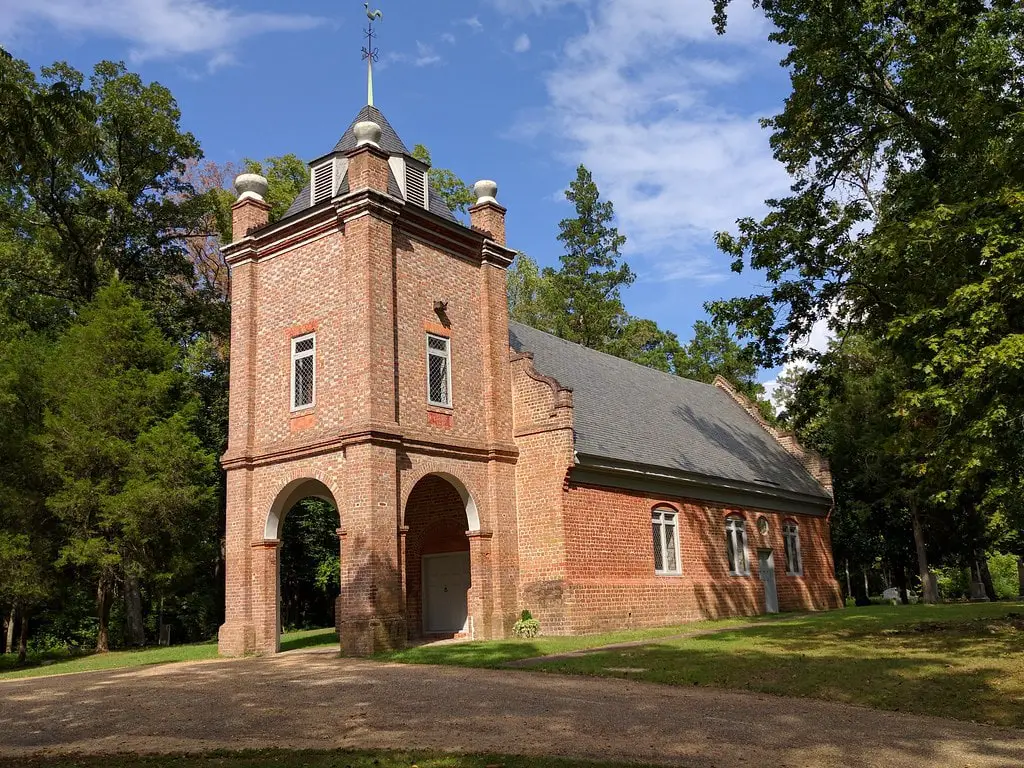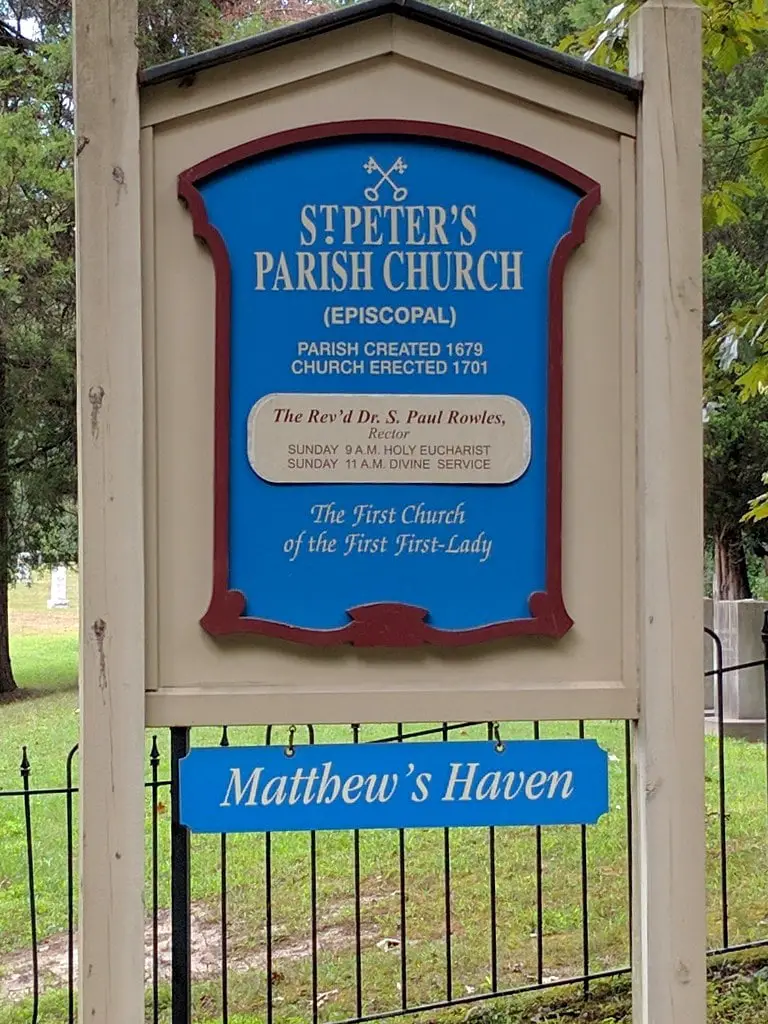The Historical Genesis of St. Peter’s Church
St. Peter’s Church, a beacon of historical and architectural significance, stands proudly in Talleysville, Virginia. Its foundations were laid down by the Virginia General Court’s decree on April 29, 1679, marking the inception of a religious and cultural landmark that would stand the test of time.
The church’s construction, a monumental project initiated in the summer of 1700, responded to the need for a more structurally sound building to replace the earlier ‘Broken Back’d Church.’ The vestry’s decision to commence this grand project led to the creation of a church that served as a place of worship and a testament to the architectural ingenuity of the era.
By July 1703, the new church was completed, its walls echoing the dedication and spirit of the community it was built to serve.
This extraordinary edifice transcends mere construction; it embodies a story intricately interlaced with the fabric of history, holding the distinction of being the most ancient parish church in the Diocese of Virginia and the third most venerable in the Commonwealth.
The church’s historical significance is further accentuated by its architectural style. As one of the few Jacobean structures in America, St. Peter’s Church offers a rare glimpse into a bygone era, its 1740 stump tower adding to its uniqueness and historical value.
The church’s connection to the community and its role in the fabric of local history is undeniable. It has been a witness to countless events and has served generations of parishioners. Its walls, if they could speak, would tell stories of faith, resilience, and unity.
As a place where people have gathered for centuries, St. Peter’s Church is not just a structure of bricks and mortar; it’s a living, breathing monument to the enduring spirit of Virginia.
For those interested in exploring the rich tapestry of local history and culture, things to do near Richmond, Virginia, include visiting this iconic church, a journey through time that offers a glimpse into the past and a testament to the architectural and spiritual legacy of the region.
Architectural Marvels of St. Peter’s Church
St. Peter’s Church is a testament to spiritual devotion and a showcase of architectural brilliance. The church’s structure, predominantly laid in English bond, is a rarity, shared by only a select few colonial Virginia churches.
This distinctive style of brickwork, characterized by alternating rows of headers and stretchers, adds strength and aesthetic appeal to the building’s exterior.
The meticulous craftsmanship in this construction technique reflects the high level of skill and attention to detail of the builders of that era.
The church’s design is further distinguished by its curvilinear gable ends, a feature meticulously restored based on evidence found during the 1940s and 1951-52 restoration works.
These gable ends not only enhance the church’s visual appeal but also speak volumes about the architectural trends and preferences of the colonial period.
The restoration efforts, undertaken with a commitment to preserving the church’s original charm, involved replacing or restoring much of the interior and exterior, ensuring that the church retained its historical integrity and stood as a symbol of the community’s enduring faith and resilience.
Moreover, the church’s architecture tells a story of evolution and adaptation. The addition of a wing before the Revolution, although later removed in the mid-nineteenth century, indicates the dynamic nature of the church’s structure, evolving to meet the needs of its congregation.
Today, St. Peter’s Church stands not just as a place of worship but also as a monument to colonial craftsmanship, a source of community pride, and a must-visit landmark for anyone interested in Virginia’s architectural heritage.

Peter’s Church and the Nation’s Founding Figures
St. Peter’s Church’s historical narrative is deeply intertwined with the lives of several of the nation’s founding figures, adding layers of historical significance to its already rich heritage.
The church was the setting for the marriage of Martha Dandridge Custis and Colonel George Washington, officiated by Rev. David Mossom, on January 6, 1759.
This event marks a pivotal moment in American history, tying the church’s legacy to the life of the first President of the United States and his family.
The church’s historical connections extend beyond the Washington family. It is believed that Letitia Christian, who later became the wife of President John Tyler, was baptized within its sacred walls in 1790.
These associations with two First Ladies of the United States highlight St. Peter’s Church’s importance as a personal and national significance site.
The church’s historical roster includes other notable parishioners and vestry members whose contributions to the church and the nation have cemented St. Peter’s Church’s status as a landmark of American history.
The church’s role in the lives of these prominent figures is a testament to its importance as a spiritual and community center, standing at the crossroads of American history and heritage.
As a custodian of these historical ties, St. Peter’s Church offers a unique window into the nation’s past, making it an invaluable asset to the community and the country.
The Church’s Role in the Civil War and Restoration Efforts
The Civil War era marked a tumultuous period in the history of St. Peter’s Church, as it became a victim of blasphemy by Federal troops.
The church’s strategic location in New Kent County, about 30 miles from Richmond, made it a focal point during the conflict.
In a blatant disregard for its sanctity, Union soldiers stabled their horses in the pews and left their marks on the brick exterior, carving their names into the walls.
This period of turmoil resulted in significant damage to the church’s structure and historical records, with most documents predating the conflict being lost.
The post-war period saw a resurgence in efforts to restore the church to its former glory. General Robert E. Lee, recognizing the church’s historical and cultural significance, notably remarked on October 23, 1869, that St. Peter’s Church, being the marital site of General Washington, should not be allowed to fall into ruin.
General William Henry Fitzhugh Lee’s son played a pivotal role in the church’s partial restoration in 1872, overseeing the project and contributing resources for its completion.
The restoration efforts were further bolstered by the dedication of individuals like Rev. Henry S. Kepler, the Evangelist of the Diocese, who became the rector at the outbreak of the war.
Funds were raised under his guidance and with the community’s support, and the church was reopened for Divine Service on November 10, 1872.
The reopening sermon was delivered by Rev. Edwin A. Dalrymple, who also contributed a stone font, a cherished artifact that the parish still possesses today.

Peter’s Church: A Symbol of Resilience and Restoration
The 20th century heralded a new era for St. Peter’s Church, marked by concerted efforts to preserve its historical integrity and restore its architectural grandeur.
The establishment of St. Peter’s Church Restoration Association on July 20, 1922, was a significant milestone in these efforts. This organization was crucial in rallying support and resources for the church’s restoration and preservation.
The Virginia General Assembly further recognized and honored the church’s historical significance when, on March 11, 1960, it designated St. Peter Parish Church as “The First Church of the First First Lady. ”
This designation underscored the church’s unique place in American history and set the stage for a comprehensive restoration project.
In 1964, with the assistance of architectural and ecclesiological experts from both sides of the Atlantic, the church underwent an elegant restoration.
The interior was meticulously returned to its colonial appearance, reflecting the church’s historical period and architectural style.
The restoration project was about preserving a building and reviving a piece of living history. The marble monument honoring Parson Mossom, the three-decker pulpit, the Holy Table, and other late 17th-century furnishings were carefully preserved or restored.
These elements and service books from the period connected to the church’s past, embodying over three centuries of spiritual service and community life.
The phrase “God preserve thy going out and thy coming in,” a sentiment deeply ingrained in the church’s ethos, perfectly encapsulates the enduring legacy of St. Peter’s Church as a symbol of resilience, restoration, and unwavering faith.
Peter’s Church Today: Preservation of History and Heritage
Today, St. Peter’s Church stands as a vibrant testament to the dedication of its congregation and community to preserving its rich history and heritage.
The church, now a revered historical landmark, continues attracting visitors from near and far, drawn by its architectural beauty and storied past.
The church’s ongoing preservation efforts ensure its structural integrity and historical significance are maintained for future generations.
Regular maintenance, guided by historical accuracy and a commitment to conservation, ensures that every brick, window, and architectural detail of St. Peter’s Church remains a living piece of history.
The church’s role in the community extends beyond its historical and architectural significance. It serves as a center for spiritual life, offering services and programs that cater to the needs of its congregation and the wider community.
The church’s calendar is filled with events celebrating its heritage, engaging with parishioners, welcoming newcomers, and fostering a sense of belonging and community spirit.
Preserving the church’s historical documents, including the Vestry Book and Register, provides invaluable resources for historians, genealogists, and anyone interested in the rich tapestry of local and national history.
St. Peter’s Church’s commitment to preserving its past is matched by its dedication to building a vibrant and inclusive future.
Through educational programs, community outreach, and cultural events, the church continues to play a pivotal role in the life of Talleysville, Virginia.
Its doors remain open, inviting visitors to step back in time, reflect on the enduring legacy of faith and community, and be part of a living history that continues to unfold.
